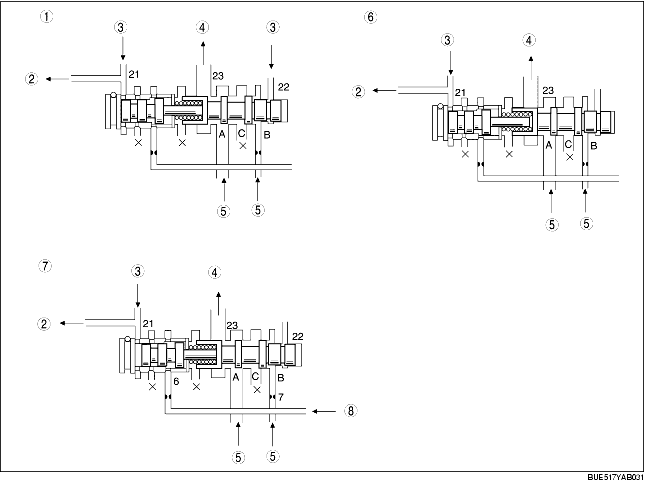
With cutback
• Line pressure (7) that is generated in the oil pump works on chambers (A) and (B). The line pressure applied to chamber (A) moves the pressure regulator valve to the left side due to a difference between the surface areas. Line pressure is then drained from chamber (C).
• As a result, the pressure regulator valve balances at the point which the (A) chamber line pressure acting toward the left balances with the spring force and modifier pressure (21) acting toward the right force.
• The line pressure (7) that works on chamber (A) becomes torque converter pressure (23) which is sent into the torque converter through the TCC control valve and TCC shift valve.
• When the accelerator pedal is depressed, modifier pressure (21) rises and is added to spring force to move the pressure regulator valve to the right side. This makes drainage of line pressure (7) from chamber (C) difficult; therefore, the pressure regulator valve balances at a high level line pressure (7).
Without cutback
• When line pressure or coasting clutch applied pressure are not applied to the cutback valve, modifier pressure (22) is applied to the right end of the pressure regulator valve, moving the valve to the left side. This makes drainage of line pressure (7) in chamber (A) easy; therefore, the pressure regulator valve balances at a low level line pressure (7).
R position
• In R position, line pressure (6) is applied to the pressure regulator valve, moving the valve to the right. This makes drainage of line pressure (7) in chamber (C) difficult; therefore, the pressure regulator valve balances at a considerably high level line pressure (7).

.
|
1
|
With cutback
|
|
2
|
To 2-3 timing valve
|
|
3
|
Modifier pressure
|
|
4
|
To TCC shift valve
|
|
5
|
Oil pump
|
|
6
|
Without cutback
|
|
7
|
R position
|
|
8
|
From manual valve
|